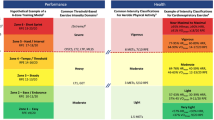Abstract
A possible relationship between aerobic fitness (AF), measured by maximal cycle ergometry (CE) and sympatho-adrenal response to acute, short lasting psycho-emotional stress was investigated by monitoring heart rate (f c) and excretion of catecholamines. The activation of the sympatho-adrenal system was characterised by the noradrenaline : adrenaline ratio. A group of 11 healthy men [22.8 (SD 2.52) years] lived under identical environmental conditions; their mean maximal oxygen uptake (\(\dot VO_{2max} \)) was 47.1 (SD 3.9) ml · min−1 · kg−1. After the physiological and psychological laboratory tests had been completed thef c of the subjects was monitored continuously during the “guerilla slide” and “parachute jump by night”, two emotionally stressful military tasks. Maximalf c (f c, max) attained during these events was 84.5% and 83% off c, max during CE (f c, max, CE), respectively. A significant relationship (r=−0.92,P<0.0002) betweenf c, max reached during the stressful tasks and\(\dot VO_{2max} \) was found only for the guerilla slide, which was preceded by physical strain, sleep deprivation and energy deficit. One subject with some prior experience in parachuting showed the lowestf c response and the lowest sympatho-adrenal activation in both events, independent of the degree of AF. In conclusion, AF was found to influence the sympatho-adrenal and fc response to acute, short-lasting emotional stress when the stressful event was aggravated by preceding physical strain, the magnitude of the stress response depending largely on individual experience and effective mechanisms for coping with specific stimuli.
Similar content being viewed by others
References
Arbeitsgemeinschaft für Ergometrie der Österreichischen Kardiologischen Gesellschaft (1978) Leitlinien für die Ergometrie. Öst Arzteztg 33:333–344
Astrand PO, Rodahl R (1977) Physiological bases of exercise. Textbook of work physiology. McGraw-Hill, New York
Baumgartner RN, Chumela WC, Roche AF (1988) Bioelectrical impedance phase angle and body composition. Am J Clin Nutr 48:16–23
Claytor RP, Cox RH, Howley ET, Lawler KA, Lawler JE (1988) Aerobic power and cardiovascular response to stress. J Appl Physiol 65:1416–1423
Czajkowski MS, Hindelang DR, Dembroski MT, Mayerson ES (1990) Aerobic fitness, psychological characteristics, and cardiovascular reactivity to stress. Health Psychol 6:676–692
Eriksson BM, Gustafsson S, Persson BA (1983) Determination of catecholamines in urine by ion-exchange liquid chromatography with electrochemical detection. J Chromatogr 278:255–263
Fibinger W, Singer G, Miller AJ (1984) Relationships between catecholamines in urine and physical and mental effort. Int J Psychophysiol 1:325–333
Hartley LH, Mason JW, Hogan RP, Jones LG, Kotchen TA (1972a) Multiple hormonal responses to graded exercise in relation to physical training. J Appl Physiol 33:602–606
Hartley LH, Mason JW, Hogan RP, Jones LG, Kotchen TA (1972b) Multiple hormonal responses to prolonged exercise in relation to physical training. J Appl Physiol 33:607–610
Henry JP (1992) Biological basis of the stress response. Integr Physiol Behav Sci 27:66–83
Herd JA (1991) Cardiovascular response to stress. Physiol Rev 71:305–330
Hoch F, Werle A, Weicker H (1988) Sympathoadrenergic regulation in elite fencers in training and competition. Int J Sports Med 9:141–145
Holmes DS, Roth DL (1985) Association of aerobic fitness with pulse rate and subjective responses to psychological stress. Psychophysiology 22:525–529
Kaji Y, Ariyoshi K, Tsuda Y, Kanaya S, Fujino T, Kuwabara H (1989) Quantitative correlation between cardiovascular and plasma epinephrine response to mental stress. Eur J Appl Physiol 59:221–226
Opstad PK (1991) Alterations in the morning plasma levels of hormones and the endocrine responses to bicycle exercise during prolonged strain. The significance of energy and sleep deprivation. Acta Endocrinol (Copenh) 125:14–22
Opstad PK, Aakvaag A (1983) The effect of sleep deprivation on the plasma levels of hormones during prolonged physical strain and caloric deficiency. Eur J Appl Physiol 51:97–107
Opstad PK, Aakvaag A, Rognum TO (1980) Altered hormonal response to short-term bicycle exercise in young men after prolonged physical strain, caloric deficit, and sleep deprivation. Eur J Appl Physiol 45:51–62
Patton JF, Vogel JA, Mello RP (1982) Evaluation of a maximal predictive cycle ergometer test of aerobic power. Eur J Appl Physiol 49:131–140
Peronnet F, Cleroux J, Perrault H, Cousineau J (1981) Plasma norepinephrine response to exercise before and after training. J Appl Physiol 51:812–815
Seals DR (1991) Sympathetic neural adjustments to stress in physically trained and untrained humans. Hypertension 17:36–43
Schwaberger G (1987) Heart rate, metabolic and hormonal responses to maximal psycho-emotional and physical stress in motor car racing drivers. Int Arch Occup Environ Health 59:579–604
Winder WW, Hagberg JM, Hickson RC, Ehsani AA, McLane JA (1978) Time course of sympathoadrenal adaptation to endurance exercise training in man. J Appl Physiol 46:766–771
Wittels P, Hosa S, Rosenmayr G, Haber P (1992) Computergestützte Ergometrieauswertung für präventivmedizinisches Training. Acta Med Austriaca [Sonderheft 2] 19:83
Ziegler MG (1989) Catecholamine measurement in behavioural research. In: Schneidermann N, Weiss S, Kaufmann P (eds) Handbook of research methods in cardiovascular behavioural medicine. Plenum Press, New York, pp 167–183
Author information
Authors and Affiliations
Rights and permissions
About this article
Cite this article
Wittels, P., Rosenmayr, G., Bischof, B. et al. Aerobic fitness and sympatho-adrenal response to short-term psycho-emotional stress under field conditions. Europ. J. Appl. Physiol. 68, 418–424 (1994). https://doi.org/10.1007/BF00843739
Accepted:
Issue Date:
DOI: https://doi.org/10.1007/BF00843739




